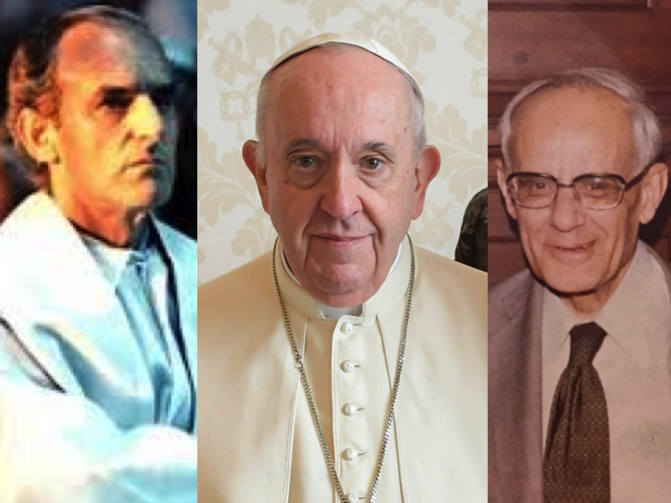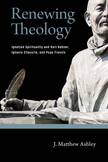Review: Pairing spirituality and theology, Ignatian style
What does the word theologian call to mind? A devout monk, prostrate on his cell floor, praying? A faithful soup kitchen volunteer? Or a self-serious, tweed-wearing type, swapping fancy metaphysical terms with other bookish people? I’ll wager it is the last.
My seminary professors’ favorite refrain was some version of “Theological study needs to be paired with worship and prayer—it needs to actually shape your life.” That this important instruction needed constant reaffirmation illustrates a fact of modernity: Theology and spirituality—two sides of what was once the same coin—are now so often treated as different currencies. One has become an academic discipline and the other a bag of tools for managing life’s difficulties. How did we arrive at such a thing as theology without spirituality? And how do we get back to a conception and practice of theology that is necessarily, and not just optionally or ideally, devout?
In Renewing Theology, J. Matthew Ashley turns to Ignatian spirituality and its exemplification in the lives and theology of three 20th-century Jesuits: Karl Rahner, Ignacio Ellacuría and Pope Francis.
In Renewing Theology, J. Matthew Ashley notes that along with this increasing division between academic theology and spirituality, there is a general feeling among Christians today that theology has little to do with their lives. Yet he argues that when brought into dynamic relation with spirituality (and vice versa), the work of theology is deeply relevant to our lives and is vital at every level of following Christ. It becomes part and parcel of a “way of life”—the life of faith.
This integration is mutually beneficial: Academic theology sans spirituality becomes little more than “technical jargon reserved for specialists” (borrowing the French philosopher Pierre Hadot’s description of philosophy), and spirituality sans theology risks “provincialism, vague romanticism, or fanaticism.” To demonstrate this relationship and the life it produces, Ashley turns to Ignatian spirituality and its exemplification in the lives and theology of three 20th-century Jesuits: Karl Rahner, Ignacio Ellacuría and Pope Francis.
Discovering in rigorous detail how the thought and work of each Jesuit takes as its guide St. Ignatius Loyola’s Spiritual Exercises, the reader begins to sense the scope of renewal that Ashley is advocating. When joined to the deep well of spirituality, theology is not mere jargon; it is an experience of God and a force for good, capable of mobilizing individual persons and entire societies. This relationship between spirituality and theology is “deeply productive,” not only for each other, but also, as Ashley illustrates throughout Renewing Theology, “for the Church and its environing society.”
Ashley makes Ignatius the book’s point of departure and conceptual anchor not because he thinks his is the only spirituality that is able to do (or that has done) this work of theological renewal, but because of his “particular aptness” for the problem at hand. Namely, Ignatius lived during modernity’s genesis and was thus forced to contend with many of the same conditions that theologians wrestle with today—the conditions which, Ashley further argues, led to this rift between theology and spirituality. He summarizes them as modern individualism, the affirmation of everyday life and life’s accelerating transience.
These conditions of modernity also gave rise to the very notion of spirituality as we know it, Ashley explains. The first condition, individualism, can be seen in contemporary spirituality’s obsession with putting the individual in touch with their ever-elusive “true self.” The second, the affirmation of everyday life, is evident in what the theologian and historian Bernard McGinn calls “the democratization of Christian mysticism,” present today in notions like “the spirituality of sexuality” or even “the spirituality of shopping.” And third, just like modernity’s transience, contemporary spirituality places a high premium on portability, rendering us “like turtles,” Ashley says, with “our havens on our backs.”
Ashley maintains that while Ignatian spirituality reflects these conditions of modernity, it is not restricted by them. Though Ignatius directs his Spiritual Exercises at the individual, for instance, he always locates them within the broader context of the church and salvific history. Moreover, Ignatius’ theological anthropology does not amount to what Charles Taylor describes as the modern, “buffered self” but is instead a firmly premodern “porous self.” Ignatian indifference is not a mode of escape but an avenue to imitate and embrace the reality of Jesus more fully. Further, his affirmation of the everyday does not lower the vision of spirituality but raises the bar for all, regardless of profession or vocation. Finally, the rootlessness of Ignatian spirituality is “consciously chosen,” leading not to fragmentation but mobilization, one present to secular time and salvific history simultaneously.
The result is not the disorienting frenzy of modernity but a sense of belonging effected by the unifying love of God. Ashley summarizes the modern self as one at work: Laboro ergo sum. Ignatius reorients the Christian to the work of God, in which the alienation of individual labor that Marx so poignantly describes is redeemed in the unifying labor of God. This unifying labor invites participation from all, the kind typified in the work of Rahner, Ellacuría and Francis. Rather than mere “havens” of fragmented spirituality, Ignatius offers these Jesuit theologians a “well of vision”—which is essential, because as Ashley notes, “Theology fails when its vision fails.”
Ashley summarizes the modern self as one at work: Laboro ergo sum. Ignatius reorients the Christian to the work of God, in which the alienation of individual labor is redeemed in the unifying labor of God.
Each figure emphasizes different aspects of the Spiritual Exercises in accordance with their unique contexts and concerns. Of chief interest to Rahner, for example, was the Taylorian “buffered self” and the disengaged world of modern secularity. For that reason, he emphasized the mystical in Ignatius, convinced that Christians could survive in the modern world only by attending to the mysterious presence of God within it, by becoming themselves mystics.
Ellacuría turned to the Exercises with less of a focus on liberating the secularized individual and more on how this mystical encounter might transform the way we view and participate in history. To him, the Exercises are instructive in developing the proper affective response to one’s present historical moment—all by way of cultivating those affections proper to the historical significance of Jesus. This “orthopathy” (right feeling), he believed, “lies at the root of the healing of the Christian social imagination and of discerning in which historical action we will, actually, encounter God.”
Finally, Ignatius’ influence on Pope Francis is evident in his emphasis on the pastoral. Francis stresses the importance in the Exercises of encountering Jesus and experiencing his mercy, of receiving his consolation and becoming capable of offering it to others, as he calls the church to do through his example. Thus, Francis finds in Ignatius the church’s mission and identity as lying in its movement beyond itself to the peripheries of society.
I could not do justice to these case studies in three brief paragraphs. Ashley achieves an impressively thorough portrayal of the lives and thought of each. He surveys their intellectual and spiritual formation, how they engage particular themes in the Exercises and, further, how they draw on these to conceptualize and respond to the conditions of modernity that were of special concern to them. Readers of varying degrees of familiarity with these three figures will all walk away, I am sure, with a fresh appreciation for their thought and work.
A major accomplishment of Renewing Theology is that it charts a way forward for a theological renewal that reflects and even welcomes the pluralism of modernity. Rahner, Ellacuría and Francis by no means agree on every point, something Ashley acknowledges. But one of the underlying theses of Ashley’s text is that theological differences are more effectively addressed when rightly situated within a robust spiritual tradition because spiritualities are capable of crossing cultural boundaries with greater ease than doctrinal issues or theological systems. They “travel easier,” and so engaging theological differences through a spiritual tradition allows for “theological dialogue that goes beyond polemical rejection or laissez-faire relativism.”
While this division between theology and spirituality that Ashley calls attention to is not itself new, the way he delineates its origins and then traces a response—from Ignatius to Francis—takes a fresh approach. To revivify theology’s relationship with a way of living in the world, Ashley does not merely demonstrate its possibility abstractly; he shows us. He shows us not just that renewing theology is needed, but imagines what it might look like, allowing readers to begin imagining how a renewal of this kind could take shape in their own theological tradition, within their own context, within their own lives. The “creative alternative” this volume offers is not a silver bullet, but a “well of vision.”
This article also appeared in print, under the headline “A Relevant Spirituality,” in the January 2024, issue.











